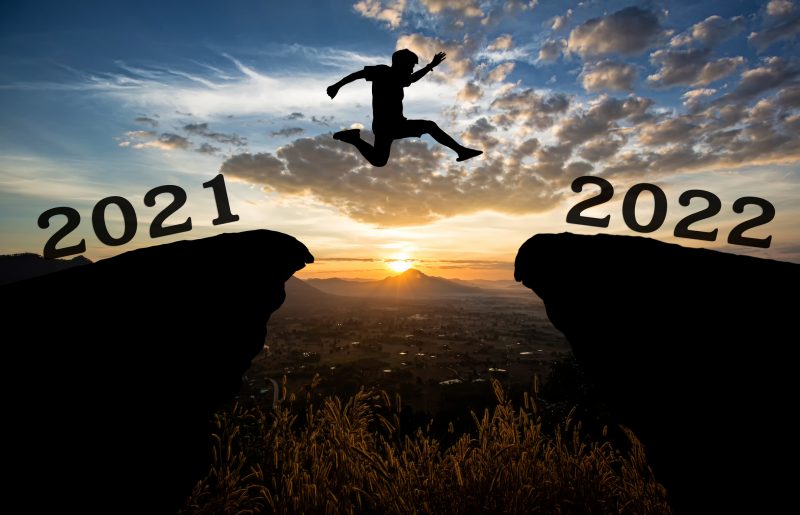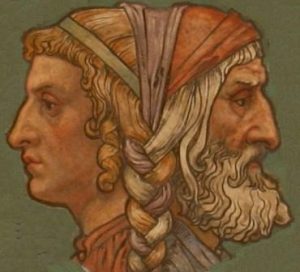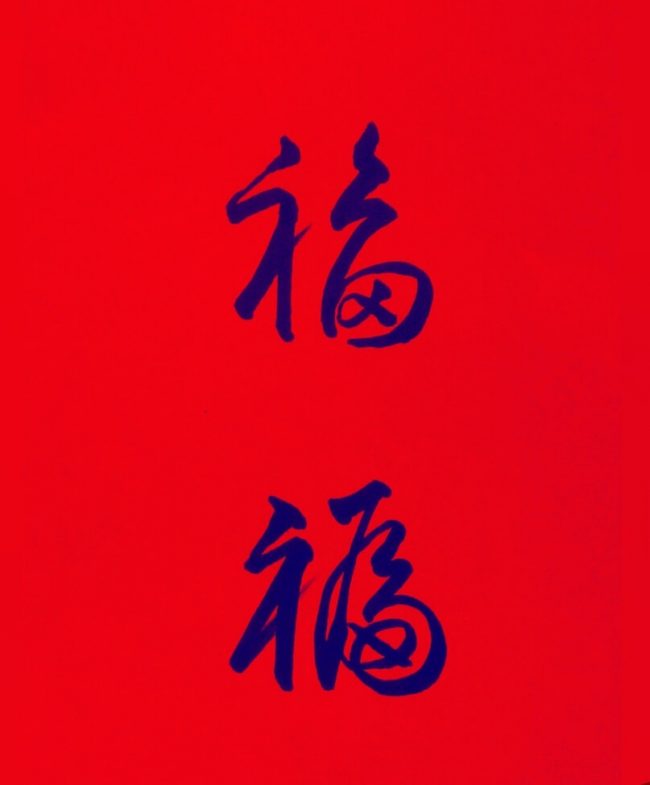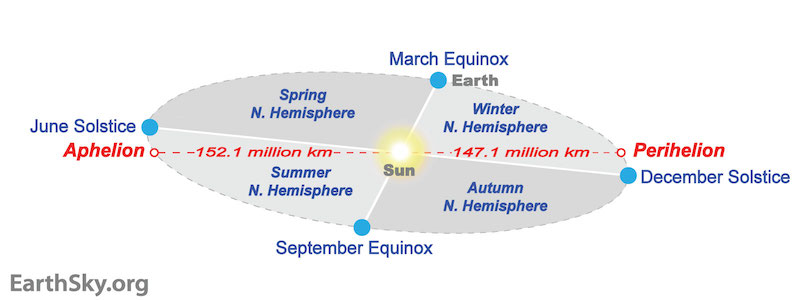
Our celebration of New Year’s Day on January 1 is a human-made creation. It’s not precisely fixed by any natural or seasonal marker. It’s a civil event, not one defined by nature. Yet, for us in the Northern Hemisphere – where daylight recently ebbed to its lowest point and the days are starting to get longer again – there’s a feeling of rebirth in the air. New Year’s resolutions, anyone?
So where does the New Year’s Day concept come from?
It stems from an ancient Roman custom, the feast of the Roman god Janus. He was the god of beginnings, gates, transitions, time, duality, doorways, passages, frames, and endings. This is also where the name for the month of January comes from, since Janus was depicted as having two opposite faces. One face looked back into the past, and the other peered forward to the future.
Likewise, on January 1, we look back at the year that just ended and forward to the new year ahead.
To celebrate the new year, the Romans also made promises to Janus. The tradition of New Year’s resolutions stems from this ancient custom. On January 1, as the year began, it was customary to exchange cheerful words of good wishes. Shortly afterwards, on January 9, the rex sacrorum – a priesthood associated with the Roman Senate – offered the sacrifice of a ram to Janus.
Today, although many do celebrate New Year’s Day on January 1, some cultures and religions have different new year dates.

Rosh Hashanah: the Jewish New Year
For example, Jews use a lunar calendar and celebrate the New Year in the fall on Rosh Hashanah, the first day of the month of Tishri, which is the seventh month of the Jewish year. This date usually occurs in September, as it did in 2021. Similar to other cultures’ New Year’s Day, the two-day holiday is both a time of rejoicing and of serious introspection, a time to celebrate the completion of another year while also taking stock of one’s life and looking ahead.
Learn more about Rosh Hashanah.

Chinese New Year
There is also the famous Chinese New Year, also known as the Lunar New Year, celebrated for weeks in January or early February. The Chinese New Year is the most important of Chinese holidays. Countries in Southeast Asia celebrate it including China, Thailand, Indonesia, Malaysia, and the Philippines. It’s also celebrated in Chinatowns and Asian homes around the world, where it’s considered a time to honor deities and ancestors and to be with family. The event always sparks a rush of travel that the New York Times has called the world’s largest annual human migration.
Last year’s Chinese New Year celebrations fell on February 12, 2021. It was the year of the Ox. In 2022, the Chinese New Year will begin on Tuesday, February 1, 2022. It’ll be the year of the Tiger.
Learn more about the Chinese New Year.

Perihelion around January 1
By the way, in addition to the longer days here in the Northern Hemisphere, there’s another astronomical occurrence around January 1 each year that’s also related to Earth’s year, as defined by our orbit around the sun. That is, Earth’s perihelion – or closest point to the sun – happens every year in early January. In 2022, perihelion comes on January 3-4.
Read more about 2022’s perihelion

History of New Year’s Day
January 1 hasn’t always been New Year’s Day.
In the past, some New Year’s celebrations took place at an equinox, a day when the sun is above Earth’s equator and night and day are equal in length. In many cultures, the March or vernal equinox marks a time of transition and new beginnings, and so cultural celebrations of a new year were natural for that equinox.
The September or autumnal equinox also had its proponents for the beginning of a new year. For example, the French Republican calendar – implemented during the French Revolution and used for about 12 years from late 1793 to 1805 – started its year at the September equinox.
The Greeks celebrated the new year on the winter solstice, the shortest day of the year.
Happy 2022, everyone!
Bottom line: We celebrate New Year’s Day on January 1 by tradition. Our modern New Year’s Day celebration stems from the ancient two-faced Roman god Janus, after whom the month of January is also named.
The post Why does the New Year begin on January 1? first appeared on EarthSky.
from EarthSky https://ift.tt/31bHoqx

Our celebration of New Year’s Day on January 1 is a human-made creation. It’s not precisely fixed by any natural or seasonal marker. It’s a civil event, not one defined by nature. Yet, for us in the Northern Hemisphere – where daylight recently ebbed to its lowest point and the days are starting to get longer again – there’s a feeling of rebirth in the air. New Year’s resolutions, anyone?
So where does the New Year’s Day concept come from?
It stems from an ancient Roman custom, the feast of the Roman god Janus. He was the god of beginnings, gates, transitions, time, duality, doorways, passages, frames, and endings. This is also where the name for the month of January comes from, since Janus was depicted as having two opposite faces. One face looked back into the past, and the other peered forward to the future.
Likewise, on January 1, we look back at the year that just ended and forward to the new year ahead.
To celebrate the new year, the Romans also made promises to Janus. The tradition of New Year’s resolutions stems from this ancient custom. On January 1, as the year began, it was customary to exchange cheerful words of good wishes. Shortly afterwards, on January 9, the rex sacrorum – a priesthood associated with the Roman Senate – offered the sacrifice of a ram to Janus.
Today, although many do celebrate New Year’s Day on January 1, some cultures and religions have different new year dates.

Rosh Hashanah: the Jewish New Year
For example, Jews use a lunar calendar and celebrate the New Year in the fall on Rosh Hashanah, the first day of the month of Tishri, which is the seventh month of the Jewish year. This date usually occurs in September, as it did in 2021. Similar to other cultures’ New Year’s Day, the two-day holiday is both a time of rejoicing and of serious introspection, a time to celebrate the completion of another year while also taking stock of one’s life and looking ahead.
Learn more about Rosh Hashanah.

Chinese New Year
There is also the famous Chinese New Year, also known as the Lunar New Year, celebrated for weeks in January or early February. The Chinese New Year is the most important of Chinese holidays. Countries in Southeast Asia celebrate it including China, Thailand, Indonesia, Malaysia, and the Philippines. It’s also celebrated in Chinatowns and Asian homes around the world, where it’s considered a time to honor deities and ancestors and to be with family. The event always sparks a rush of travel that the New York Times has called the world’s largest annual human migration.
Last year’s Chinese New Year celebrations fell on February 12, 2021. It was the year of the Ox. In 2022, the Chinese New Year will begin on Tuesday, February 1, 2022. It’ll be the year of the Tiger.
Learn more about the Chinese New Year.

Perihelion around January 1
By the way, in addition to the longer days here in the Northern Hemisphere, there’s another astronomical occurrence around January 1 each year that’s also related to Earth’s year, as defined by our orbit around the sun. That is, Earth’s perihelion – or closest point to the sun – happens every year in early January. In 2022, perihelion comes on January 3-4.
Read more about 2022’s perihelion

History of New Year’s Day
January 1 hasn’t always been New Year’s Day.
In the past, some New Year’s celebrations took place at an equinox, a day when the sun is above Earth’s equator and night and day are equal in length. In many cultures, the March or vernal equinox marks a time of transition and new beginnings, and so cultural celebrations of a new year were natural for that equinox.
The September or autumnal equinox also had its proponents for the beginning of a new year. For example, the French Republican calendar – implemented during the French Revolution and used for about 12 years from late 1793 to 1805 – started its year at the September equinox.
The Greeks celebrated the new year on the winter solstice, the shortest day of the year.
Happy 2022, everyone!
Bottom line: We celebrate New Year’s Day on January 1 by tradition. Our modern New Year’s Day celebration stems from the ancient two-faced Roman god Janus, after whom the month of January is also named.
The post Why does the New Year begin on January 1? first appeared on EarthSky.
from EarthSky https://ift.tt/31bHoqx

Aucun commentaire:
Enregistrer un commentaire